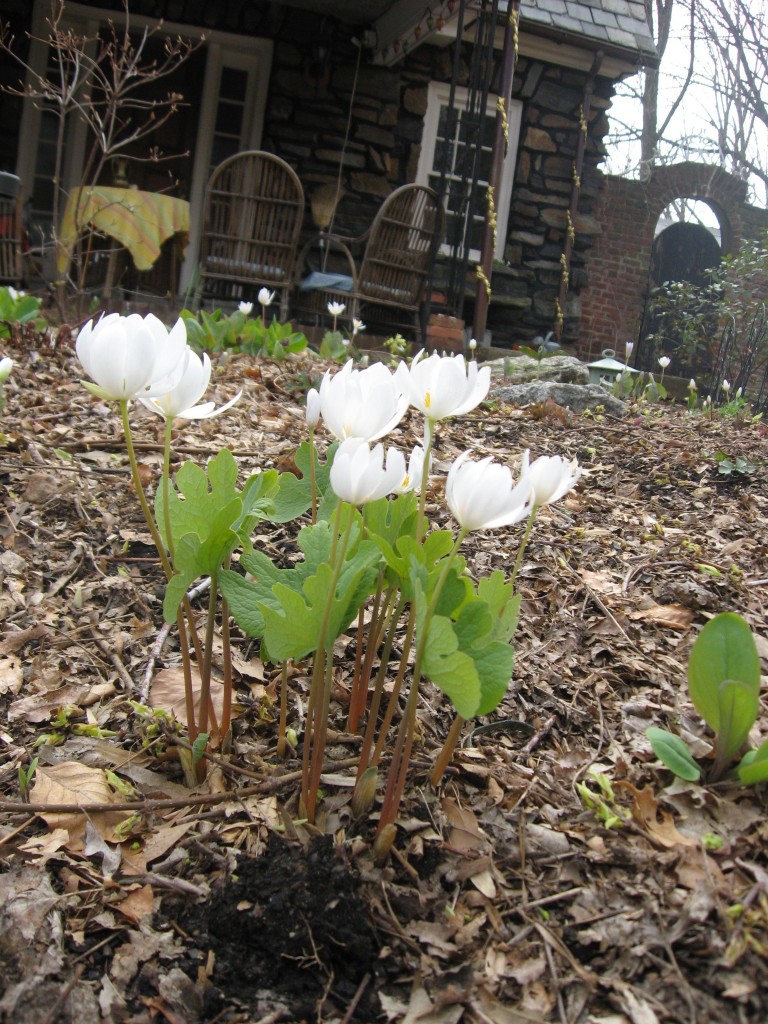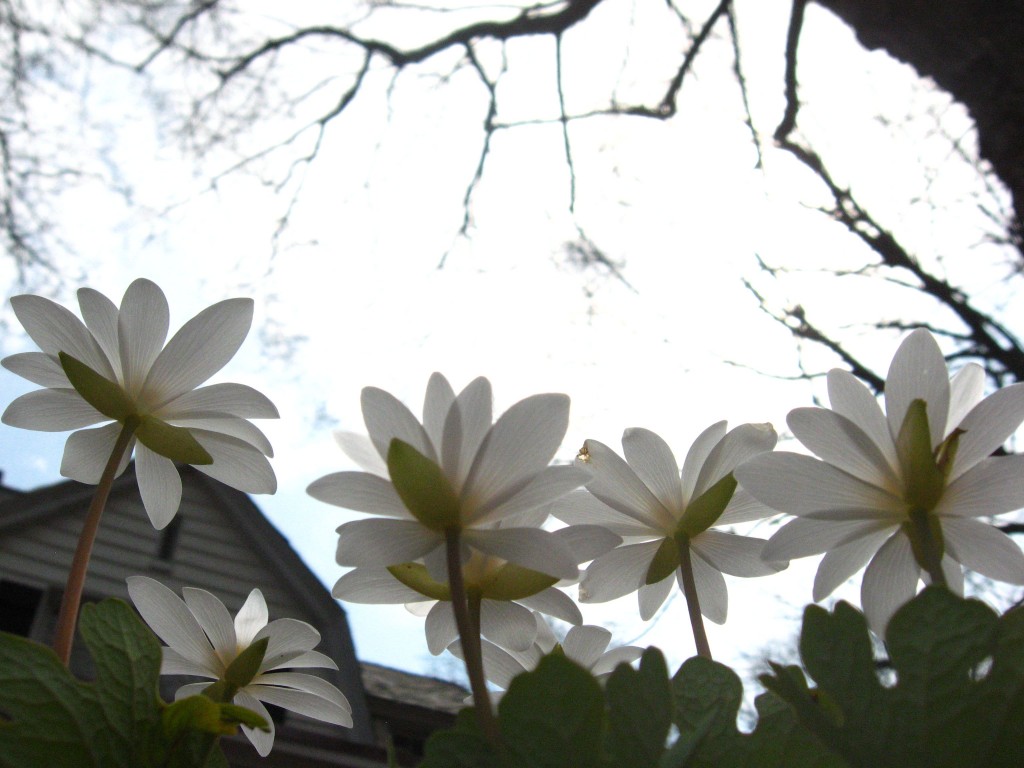
This is our dream garden. Â Our yard was covered in Pachysandra terminalis and Hedera helix. We joked that it would be so cool if we had Bloodroot as a groundcover instead of the Pachysandra, which has invaded into the park. That was 4 years ago. This vision was the start of a great adventure and learning experience. We have had so much pleasure in creating a garden of plants native to our area of Southeastern Pennsylvania.
We started out very much admiring the plants that grow in the adjacent Morris Park. Â Bloodroot, Mayapples, Wild Geranium, and the native coral Honeysuckle. Â Emulating the forest plants was a great start, being that we know that these plants will do well in the area. Â It turns out that Redbud Nursery, just 20 minutes from our house sells these plants. Our friends who are native plant enthusiasts made us aware of this great local resource for native plant gardening.
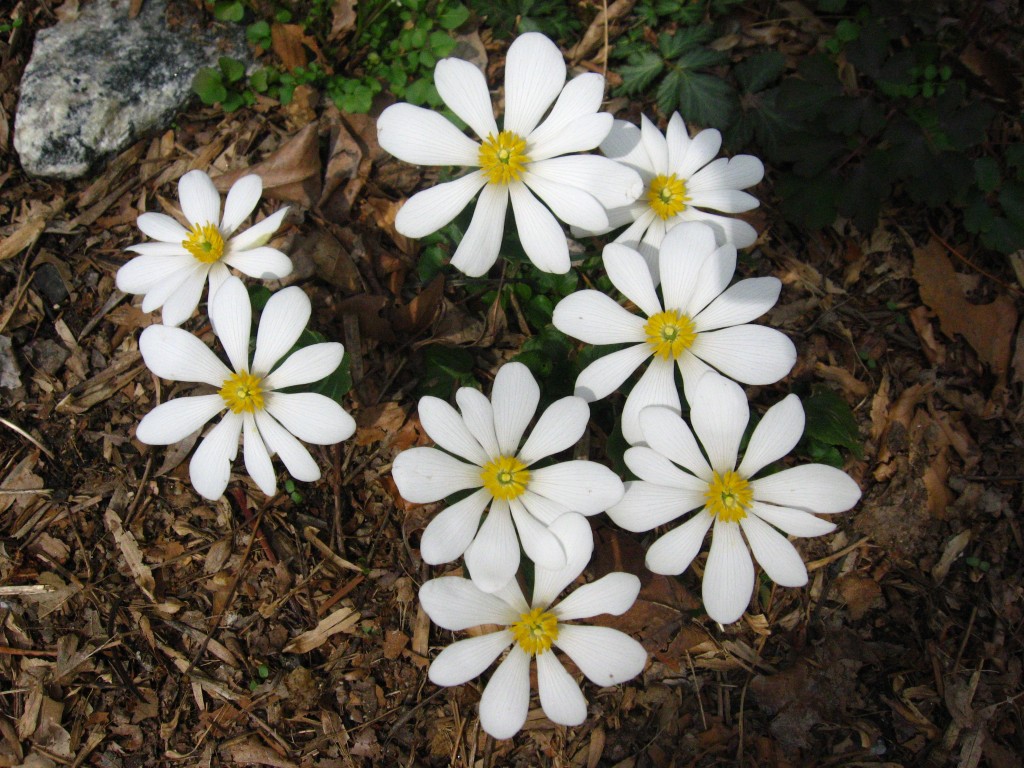
So we took the plunge and ripped out the entire yard, which was 100% non-native Japanese Pachysandra and English ivy.  It was a barren wasteland until we realized we had Bishops weed (Aegopodium podagraria) and Vinca Vine (Vinca minor) also growing there. These are two plants that have been marketed to gardeners as a good groundcover for yards.  It turns out that they are also non-native, invasive plants that are jumping the fence, and invading natural areas all across the east coast, threatening native , naturally occurring plant populations.  To this day, we are still trying to rid our yard of these noxious weeds. These three invasives run from the yard into the park and make it hard for native woodland herbaceous plants to survive.
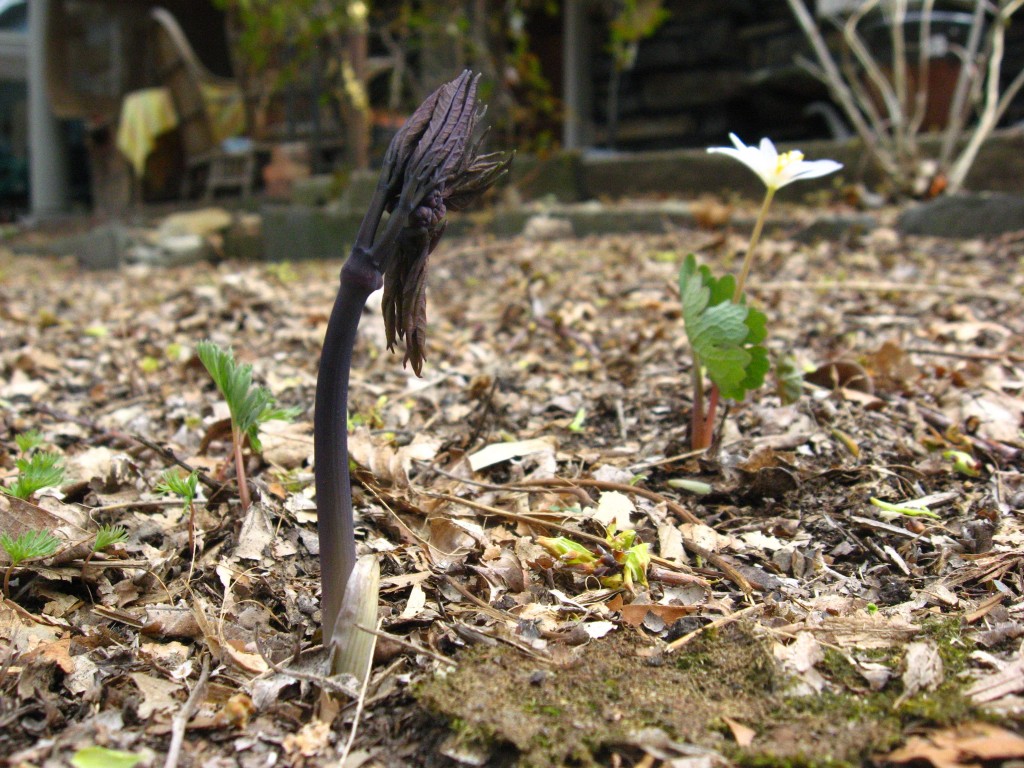
Early on in our adventure of native plant gardening, we stumbled upon a program on WHYY, an interview with entomologist Douglas Tallamy on Radio Times. Â Listening to Doug Tallamy was an everlasting inspiration. Â “Garden as if your life depended on it” – that is what he eventually wrote on our copy of his book, Bringing Nature Home. Doug Tallamy’s message revolves around the fact that you cannot rely on designated natural areas such as Morris Park only, to sustain the biodiversity that we need to survive. Â It is essential to create corridors of sustainable habitats to maintain that biodiversity. Â Our own yards don’t have to be a sterile lawn full of ornamental cultivars that do not contribute to the ecosystem, but instead can become an integral part of those essential corridors.
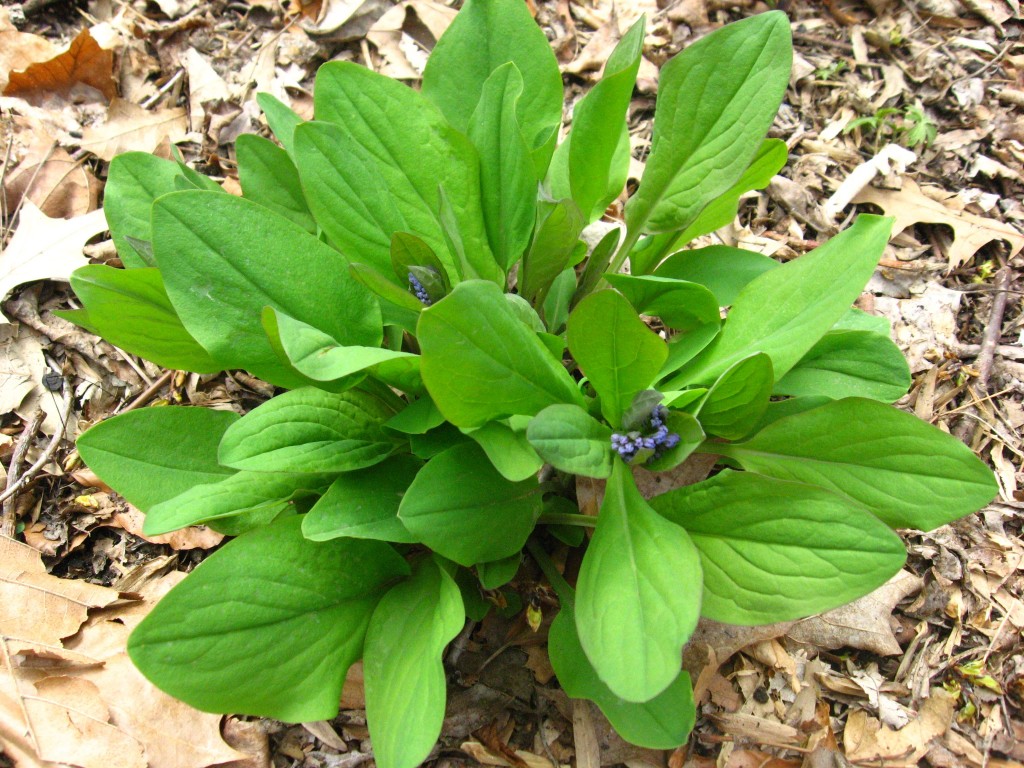
The yard is not all that large and heavily wooded. We even have a Sugar Maple (Acer saccharum) growing in the yard. Â This is a challenging native tree to grow a garden around because it is very shady and it has lots of roots close to the surface. Â We manage, grateful that it is not the invasive exotic Norway Maple or some other problematic non-native tree.
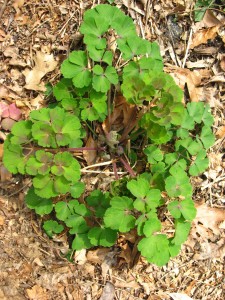
We  have adjusted to the conditions and have embraced the shade garden concept. It is fun to experiment with different plants that are native to our area, to see them actually grow in our yard.  We buy plants that are native to the area of Southeastern Pennsylvania. We prefer ones that are propagated from a local seed source, if we can have the luxury of such an option.  What is really fun about it is seeing a specimen of our garden plants growing in the wild.  When our native Columbine was withering away under the shade of the Sugar maple, we puzzled over its descent.  Then we saw ones growing in the wild.  They were blooming, and located on a hillside with some sun, but with some trees as well.  So they do like some sun to thrive. We remembered this hillside, and we moved our Columbine (Aquilegia canadensis) in the fall to another location, in the backyard, with some sun, and we anticipate them to do better. The above picture is one of them in its new location.  It looks to be in good shape, perhaps it will bloom.  Even if it doesnt bloom, watching the leaves unfurl and the plant establish itself is great entertainment.
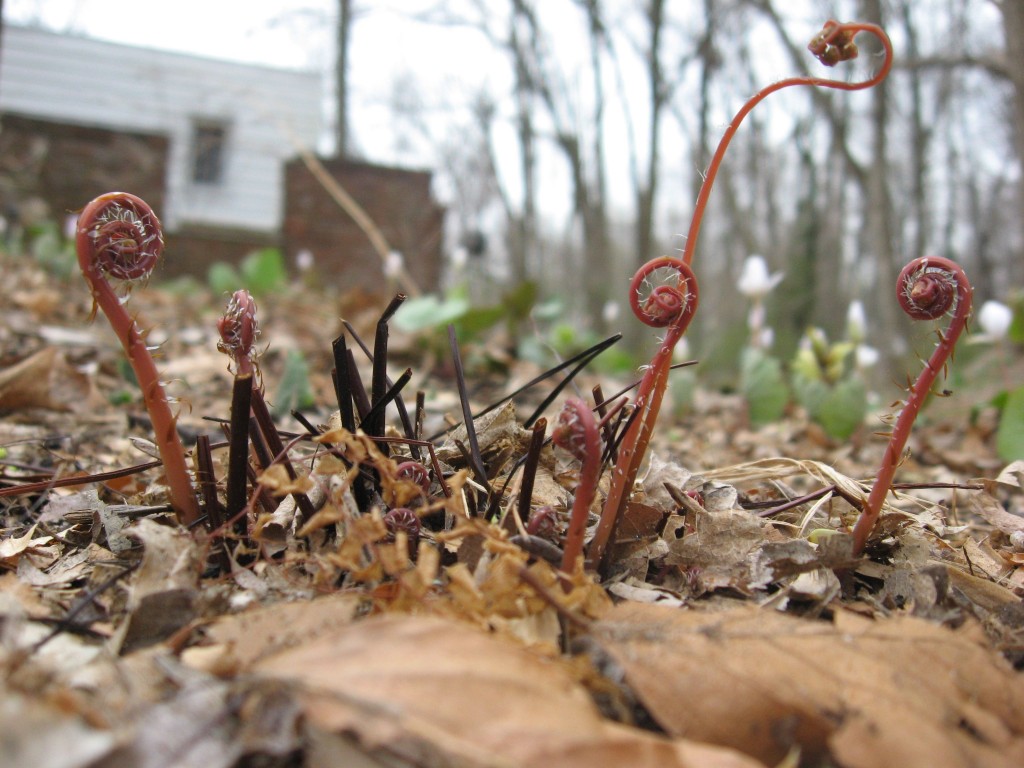
This incredible unfurling spirally red thing is Adiantum pedatum, the Maidenhair fern. Â These ferns love our yard. Â One theory is they like a bit of lime in their soil and when they built these houses they mixed up the mortar on site in front of the houses and the lime in the mortar ended up in the soil they grow out of. Â They also seem to like protected areas and grow near cliffs or on the slopes of steep ravines, often in quite some shade. Â Imagine the stone house as a cliff. These ferns love the yard, and we encourage people to try them in their yards as well. Â We first saw one in the wild in Ridley Creek State Park, and we were very excited about this. Â We then saw one in Shenks Ferry Wildflower Preserve, where they are very occasional.
However, this experience was tainted by the fact that an overzealous photographer had crushed the blooming Trillium  erectum var album growing around it in order to get up close to the fern for a photograph. We can only assume that the well-meaning photographer and lover of flowers and plants was so eager to get a picture of the Maidenhair fern that they were shaking with excitement and they dropped their tripod and then tripped on a rock, subsequently crushing the blooming trilliums and leaving a horrific scar on the landscape for all to bear witness.  The photographer, haunted by the crushed aspirations of these trilliums (which worked for an entire year of photosynthesis only to be crushed just before they could set seed), is now a vocal advocate of trail and nature photography etiquette and stewardship, we can only hope.
The third time we saw a Maidenhair fern growing in the wild was along the James River in Virginia, just one month ago. All we saw were the old fronds resting on the leaf litter near the dormant fiddleheads poking out  of a rocky, steep slope running right up to the river’s edge.  See our post Virginia is for Rivers. Here we found a quiet, undisturbed riverside, with a barely used path, in an area we could tell was  rich with biodiversity and botanical interest.
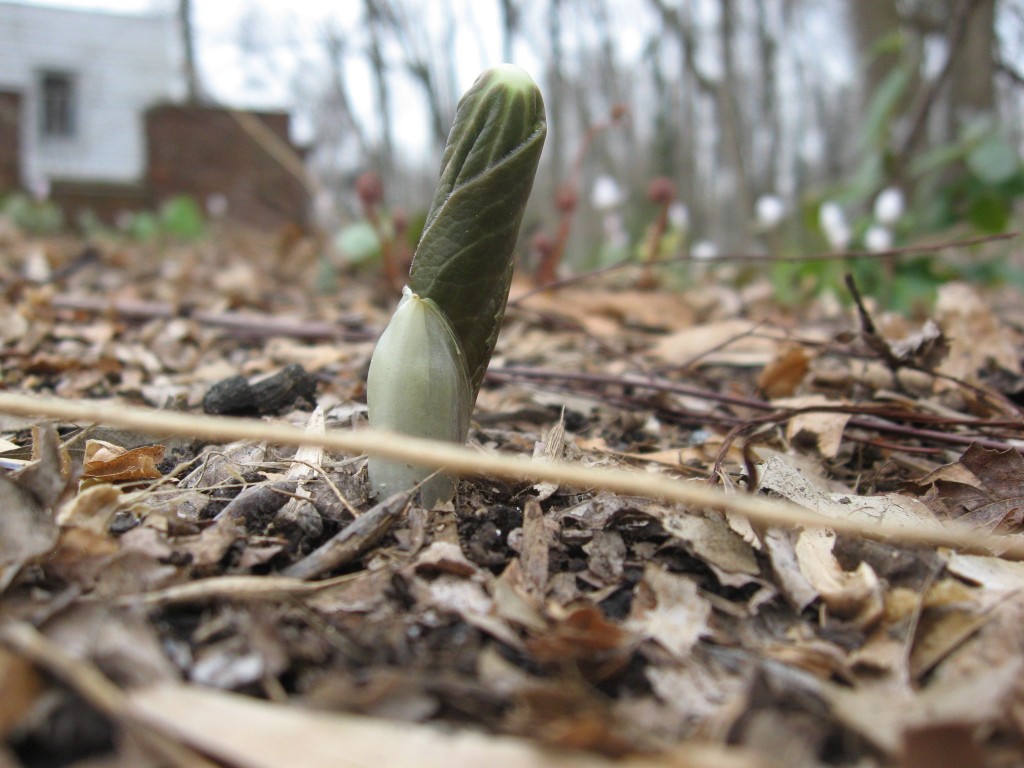
Mayapple is moving out of its winter shell. Mayapple (Podophyllum peltatum) is a great garden flower.  They are abundant in the woods of Morris Park, and form colonies of woodland umbrellas.  The double umbrellas create a waxy white flower that nods below the two umbrellas.  This plant is the most entertaining to watch break out of the pointy white capsule that  encases its embryonic form all fall and winter, and rise up into the world, ready for photosynthesis and  flower and seed production.  A whole colony of the green umbrellas in the spring is a woodland herbaceous version of the image of the Jersey Shore in July and August, or of the Fancy Brigades parading up Broad Street  and partying down Two Street on New Years Day here in Philadelphia. On this day, there are many hundreds of festive satin umbrellas bobbing up and down along the streets of South Philadelphia.  One year it dawned on us that the image is reminiscent of a colony of  Mayapples in the spring.
Nonetheless, if you have a shady area in your yard, these plants are highly recommended and available at native plant nurseries. They propagate well and will stay into the month of October if watered enough.
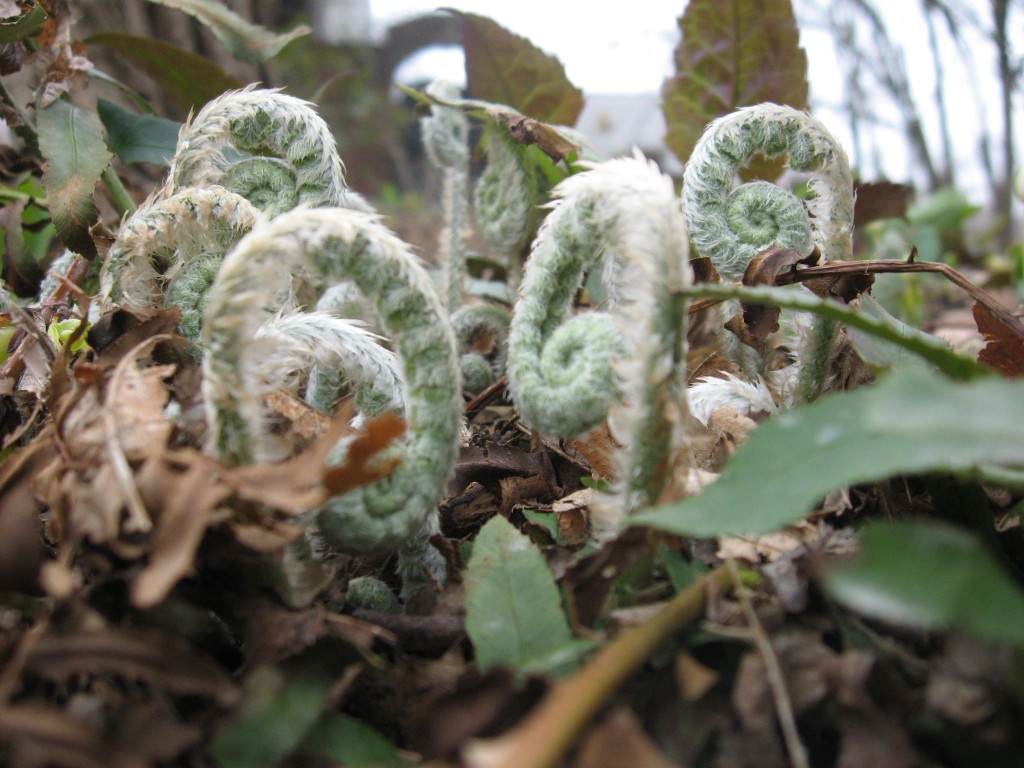
What are these feathered curled-up wild things? Polystichum acrostichoides, the Christmas fern. From a garden perspective, this is a native treasure.  By the way, the picture above is the most charming image we can present at this time. This fairy-tale scene is not a movie set, but a West Philadelphia yard.  This fern gives our yard the seal of woodland authenticity.  It is at once a wild-looking fern that reads forest landscape, and yet a very distinguished, compact and well-defined fern that at the same time has a formal appearance. It bridges the divide between its wild  reality and the human need for definition and discipline in the plant world. On top of that, this fern is evergreen, giving the native plant garden a winter architectural presence. This Fern is a landscape architect in and of itself.
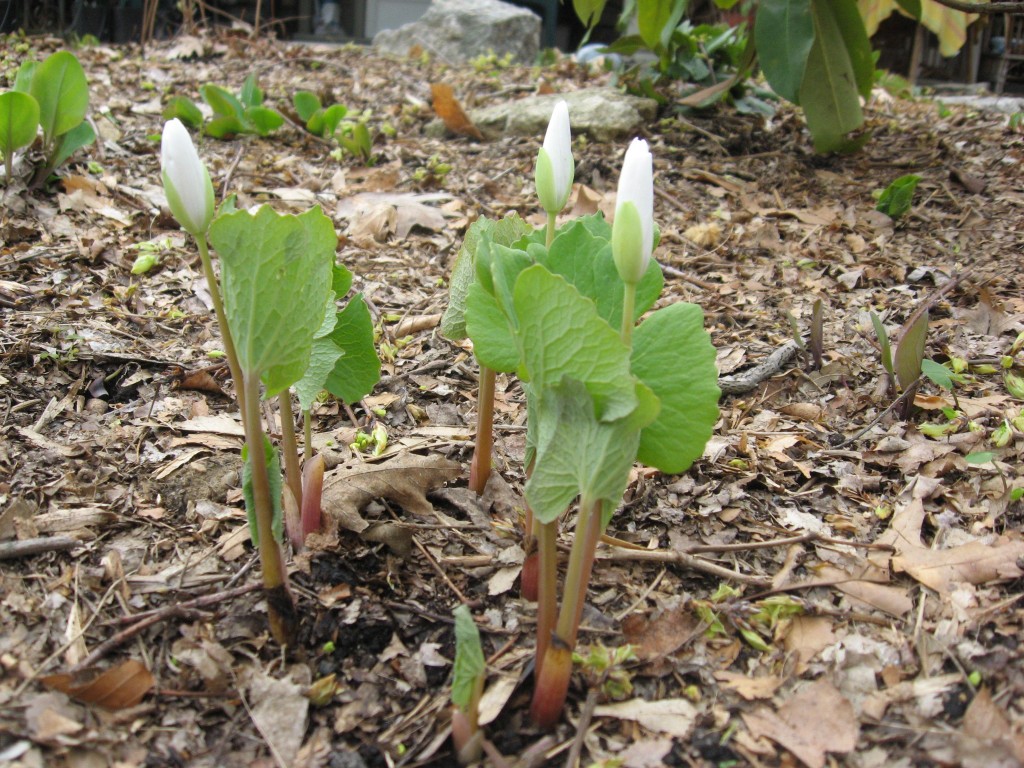
We at the Sanguine Root have found that gardening is an emotional experience. Â Plants resonate in our being, and they stir our source. They can be a source of joy and peace, and a source of fear. Â Poison-ivy and stinging nettles, weeds that invade our vegetable gardens or grow out the sides of our houses are the first to come to mind. Â Because plants are our absolute source of survival, they have become something of the ‘elephant in the room’ our favorite expression. In Philadelphia, we are at the mercy of Ailanthus altissima, the ‘tree of heaven’. Â If left uncontrolled, this plant will destroy all of our buildings in less than ten years.
In the city, a long dreary winter can be officially ended with the  blooms of a daffodil.  For us, it is the Bloodroot plant that marks the end of one season and the beginning of another.  We want to share our enthusiasm for this native wildflower.  This flower has captured our imaginations and has driven us to be interested and learn about native plants and in botany itself. Pictured above, this specimen of Bloodroot in our yard  has the biggest leaves in comparison to the other patches of Bloodroot. Keeping up with the plant world  is a fascinating pursuit of knowledge.
